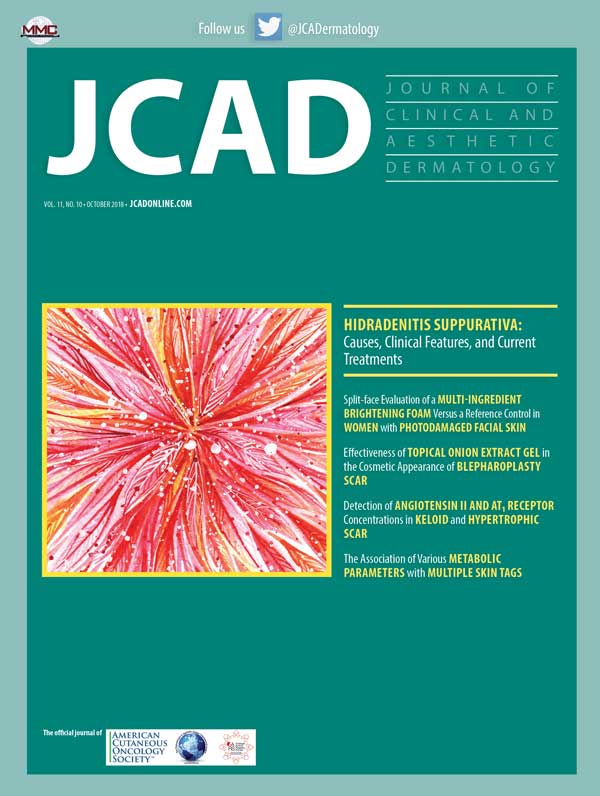 VOL. 11, NO. 10 • October 2018
VOL. 11, NO. 10 • October 2018
Dear Colleagues:
Welcome to the October 2018 issue of The Journal of Clinical and Aesthetic Dermatology. We start this issue with a review article titled, “Hidradenitis Suppurativa: Causes, Features, and Current Treatments,” by Vinkel and Thomsen. In this article, the authors describe the chronic inflammatory skin disorder—hidradenitis suppurativa (HS)—and review its diagnosis and treatment methods. Though HS is a relatively common skin condition, patients might experience long delays in proper diagnosis—potentially due to disease unawareness among physicians—which can increase the negative impact HS has on quality of life. “Increased knowledge of HS is…important in order to optimize disease management and ultimately improve the quality of life of patients,” conclude the authors.
Next, Owji et al present the results of their split-face study, “Effectiveness of Topical Onion Extract Gel in the Cosmetic Appearance of Blepharoplasty Scar.” For this double-blind, prospective study, researchers compared the effectiveness of topical onion extract gel with petroleum jelly on the appearance of blepharoplasty scars. Blinded participants applied topical onion extract gel to the blepharoplasty scar on one side of the face and petroleum jelly to the other side, twice daily for two months following suture removal. Participants then were evaluated objectively using the Manchester Scar Scale at the end of treatment, and a follow-up phone interview was conducted six months later. The authors reported that no statistically significant difference was observed in overall cosmetic appearance objectively and/or subjectively between the topical onion extract gel and the petroleum-based ointment.
Following this, in the article, “Detection of Angiotensin II and AT1 Receptor Concentrations in Keloid and Hypertrophic Scar (HTS),” Niazi et al report the results of their study in which skin biopsy samples from HTS, keloid, and normal skin tissues were collected and evaluated for angiotensin II and AT1 receptor concentrations. The researchers found that angiotensin II was higher among the HTS samples compared with the normal and keloid samples, while the AT1 receptor concentration was higher among the keloid samples compared with the HTS and normal skin samples. The authors concluded that angiotensin II and AT1 receptor concentrations might stimulate the formation of HTS and keloid and suggest that angiotensin II receptor blockers and angiotensin-converting enzyme inhibitors could potentially be suitable compounds for the treatment of scar tissue.
Next, in the article, “The Association of Various Metabolic Parameters with Multiple Skin Tags (STs),” Platsidaki et al sought to determine if there was a significant association between obesity, diabetes mellitus, hyperlipidemia, thyroid abnormalities, acanthosis nigricans, and multiple STs in a Greek primary population. After analyzing phototype, body weight, and serum blood samples of their study participants, the authors reported that patients who were overweight with Fitzpatrick Skin Type III, acanthosis nigricans, and hypothyroidism were more likely to present with multiple skin tags than patients at a normal weight with Skin Type I. Larger sample sizes are needed to support their observations.
Following this, Stephens et al present the results of their study, “Split-face Evaluation of a Multi-ingredient Brightening Foam Versus a Reference Control in Women with Photodamaged Facial Skin.” Here, in this 12-week, investigator-blinded, randomized trial, researchers compared the safety and efficacy of a 2% hydroquinone multi-ingredient foam with a standard 4% hydroquinone cream on photodamaged facial skin of women. Results indicated that both products improved the appearance of photodamaged facial skin and were well-tolerated, with no observed statistically significant changes between treatments during the efficacy or tolerability evaluations.
We hope you enjoy this issue of JCAD, and as always we welcome your feedback and submissions.
With regards,
James Q. Del Rosso, DO, FAOCD—Editor-in-Chief, Clinical Dermatology
Wm. Philip Werschler, MD, FAAD, FAACS—Editor-in-Chief, Aesthetic Dermatology
Seemal R. Desai, MD, FAAD— Associate Editor

